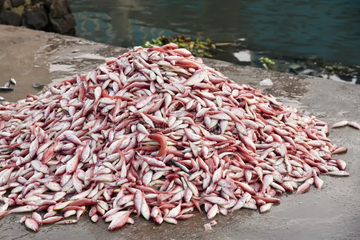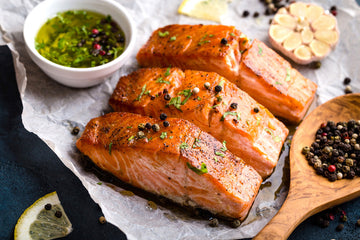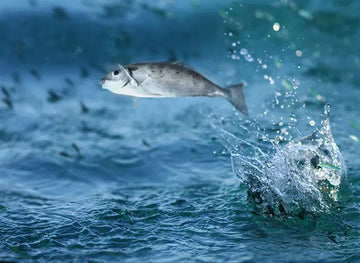Current Scenario of the INDIAN Fish Food chain

Fig: Fish at the harbour (no cold chain)

Fig: Fish transportation without proper icing

Fig: Fish reaches the market with insufficient cold chain

Fig: Fish kept openly for display for customers.
The above images remind the current situation of the marketplace. We blindly trust the quality of the fish which we get from the market. But what we see cannot be validated since there is no traceability in the supply chain. Temperature maintenance is a major concern for the quality of the product from the time of harvest till it reaches the kitchen. The document below has listed the method of handling the fish after harvest as per the Food and Agricultural Organization (FAO). The necessity to maintain a cold chain and the ideal process to follow a cold chain as per the FAO regulation is as follows.
What is Chilling of Fish?
“Chilling is the process of cooling fish or fish products to a temperature approaching that of melting ice.”
The purpose of chilling is to prolong the shelf-life of fish, which it does by slowing the action of enzymes and bacteria, and the chemical and physical processes that can affect quality. Fresh fish is an extremely perishable food and deteriorates very rapidly at normal temperatures. Reducing the temperature at which the fish is kept lowers the rate of deterioration. During chilling the temperature is reduced to that of melting ice, 0 °C/32 °F. The most common means of chilling is by the use of ice. Other means are chilled water, ice slurring (of both seawater and freshwater), and refrigerated seawater (RSW). For the full benefits of chilling to be realized, it is essential to maintain chill temperatures throughout the different fish-handling operations.

Fig: Time-Temperature graph for different types of icing methods.
The fastest and most efficient chilling medium is ice slurry followed by RSW. The ice chilling rate is the lowest due to reduced contact of ice with the fish (an air layer surrounding the fish was created during ice meltage). To ensure maximum contact of ice with the fish, proper selection of the size of ice particles and good stowage practices are needed. The rate of chilling is governed by:
- The size, shape, and thickness of fish;
- The method of stowage;
- Adequate mixing of ice, water, and fish (in ice slurries);
- Adequate contact of ice with the fish;
- The size of the ice particles.
Factors affecting the rate of spoilage in fish
The main factors that affect the rate of spoilage in chilled fish are:
- Temperature
- Physical damage
- Intrinsic factors
Temperature
High temperatures increase the rate of fish spoilage and low temperatures slow it down. Therefore, if the temperature of fresh fish is low, then quality is lost slowly. The faster a lower temperature is attained during fish chilling, the more effectively the spoilage activity is inhibited for this the icing ratio ideal is 1:1 for storage.
Physical damage
Fish is soft and easily damaged, therefore rough handling and bruising result in the contamination of fish flesh with bacteria and allow the release of enzymes, speeding up the rate of spoilage. Careless handling can burst the guts and spread the contents into the fish's flesh.
Intrinsic factors

Shelf-life of fish in ice
Chilling fish can slow down the spoilage process, but it cannot stop it. Therefore, it is a race against time and fish should be moved as quickly as possible.
VTF Process for Icing for 100% Traceable Cold Chain
Fish are poikilotherms. Its circulatory system is very simple, because there is no fat layer under the skin, so it cannot maintain its own body temperature, and will change with the external environment. At VTF we follow a process of chill killing (Slurry ice method) of the fish as soon as the fish is out of water. The temperature of the fish's body is close to zero degrees at the time of death of the fish. This ensures that the fish is killed in a humane manner that retains the nutrients in its natural form without any degradation.
The icing ratio practised at VTF is 1:1 (Fish: Ice) for the best efficiency in the quality storage of fish. VTF maintains the temperature of the fish in the chilled form right from the death of the fish, during transportation, at different stages of processing till the cold chain delivery at doorsteps. Hence the nutrients in fish at retained in without the use of any form of preservatives or food additives for preservation.

Fig: Harvest and packing in cold chain

Fig: Cold chain inspected at processing unit

Fig: Cold chain maintained in Processing unit

Fig: Cold chain assured till the customer doorsteps
Bibliography
- https://www.fao.org/3/x5893e/x5893e01.htm#Chilled%20fish%20display.
- https://www.fao.org/3/y5013e/y5013e04.htm.
- https://kb.rspca.org.au/knowledge-base/how-can-farmed-fish-be-slaughtered-humanely/
Prepared by
Abin S.N
(MSc Industrial Fisheries and Fish Biologist)





